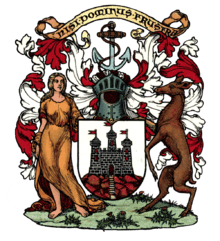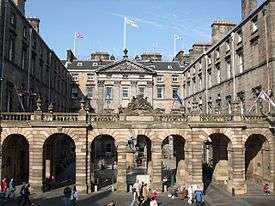City of Edinburgh Council
The City of Edinburgh Council is the local government authority for the City of Edinburgh. It was created in 1996 under the Local Government etc. (Scotland) Act 1994, with the boundaries of the post-1975 City of Edinburgh district of the Lothian region.
City of Edinburgh Council | |
|---|---|
| Full council election every 4 years | |
 Coat of arms | |
 Logo | |
| Type | |
| Type | |
| History | |
| Preceded by | City of Edinburgh District Council |
| Leadership | |
Leader of the Council | |
Chief executive | Andrew Kerr since 27 May 2015 |
| Structure | |
| Seats | 63 |
 | |
Political groups |
|
| Elections | |
| Single transferable vote | |
Last election | 5 May 2017 |
Next election | 5 May 2022[2] |
| Motto | |
| Nisi Dominus Frustra | |
| Meeting place | |
 | |
| Edinburgh City Chambers | |
| Website | |
| www | |
History
Prior to the Local Government (Scotland) Act 1973 Edinburgh was administered by the single tier "Edinburgh Corporation", which covered the "City and Royal Burgh of Edinburgh". As such, the Edinburgh Corporation was responsible for local government services, such as the Edinburgh Corporation Transport Department (Edinburgh Corporation Tramways until 1928). The Edinburgh Corporation had the power to make Burgess (freemen) of the City of Edinburgh and to grant "Seals of Cause" to guilds and trade organisations. The Edinburgh Corporation awarded Burgess Ticket through the Lord Dean of Guild, an office in the Corporation. Like the Corporation of the City of London, Burgess Tickets were often awarded along with a 'Freedom Casket' – a container to hold the ticket. Bodies such as the Merchant Company of Edinburgh, the Incorporated Trades of Edinburgh and The High Constables of Edinburgh formed part of the corporation, contributing councillors and law enforcement officers. The Edinburgh Corporation had the power to institute these organisations via the granting of a "Seal of Cause". This empowered the societies as "a legal corporation with power to hold property, make its own by-laws and regulations". Other organisations to receive the "Seal of Cause" include The Royal Burgess Golfing Society of Edinburgh, who received their seal on 2 July 1800.[3] The history of the corporation lives on elsewhere around the city, for example in the name of the members of Muirfield golf club, who were granted a charter by the corporation in 1800 becoming "The Honourable Company of Edinburgh Golfers". Many of Edinburgh's ceremonies and traditions date back to the days of the Edinburgh Corporation, such as the Edinburgh Ceremony of the Keys, where the Lord Provost symbolically hands the keys to the City of Edinburgh to the monarch, who hands them back to the Lord Provost proclaiming "that they cannot be placed in better hands than those of the Lord Provost and Councillors of my good City of Edinburgh".[4]
In 1975, Edinburgh Corporation was abolished.[5] The new two-tier system consisted of Lothian Regional Council (with responsibility for water, education, social work and transport) and the City of Edinburgh District Council (with responsibility for cleansing and libraries). The City of Edinburgh became a single-tier council area in 1996, under the Local Government etc. (Scotland) Act 1994, with the boundaries of the City of Edinburgh district of the Lothian region. The district had been created in 1975, under the Local Government (Scotland) Act 1973, to include the former county of city of Edinburgh; the former burgh of Queensferry, the district of Kirkliston and part of Winchburgh formerly within the county of West Lothian; and the district of Currie and the parish of Cramond formerly within the county of Midlothian.[5]
Elections
The last election to the council was held on Thursday, 4 May 2017.[6]
Members of the council represent 17 electoral areas called wards. As a result of the Local Governance (Scotland) Act 2004, multi-member wards were introduced for the 2007 election, each electing three or four councillors by the single transferable vote system, to produce a form of proportional representation. Previously each of 58 wards elected one councillor by the first past the post system of election.
Wards
| Ward number | Ward name | Seats |
|---|---|---|
| 1 | Almond | 4 |
| 2 | Pentland Hills | 4 |
| 3 | Drum Brae/Gyle | 3 |
| 4 | Forth | 4 |
| 5 | Inverleith | 4 |
| 6 | Corstorphine/Murrayfield | 3 |
| 7 | Sighthill/Gorgie | 4 |
| 8 | Colinton/Fairmilehead | 3 |
| 9 | Fountainbridge/Craiglockhart | 3 |
| 10 | Morningside | 4 |
| 11 | City Centre | 4 |
| 12 | Leith Walk | 4 |
| 13 | Leith | 3 |
| 14 | Craigentinny/Duddingston | 4 |
| 15 | Southside/Newington | 4 |
| 16 | Liberton/Gilmerton | 4 |
| 17 | Portobello/Craigmillar | 4 |
Electoral History
| Election | Control | Administration | |
|---|---|---|---|
| 1972 | No overall control | Progressive-Conservative minority | |
| 1973 | No overall control | Conservative-Progressive minority | |
| 1974 | No overall control | Labour minority | |
| 1977 | Conservative | Conservative | |
| 1980 | No overall control | Conservative minority (Liberal support) | |
| 1984 | Labour | Labour | |
| 1988 | Labour | Labour | |
| 1992 | No overall control | Labour | |
| 1995 | Labour | Labour | |
| 1999 | Labour | Labour | |
| 2003 | Labour | Labour | |
| 2007 | No overall control | Lib Dem – SNP | |
| 2012 | No overall control | Labour – SNP | |
| 2017 | No overall control | SNP – Labour | |
See also
References
- Stephen, Phyllis (18 May 2017). "Interview with the new Lord Provost at City Chambers". Retrieved 9 February 2019.
- Council, The City of Edinburgh. "Upcoming elections". www.edinburgh.gov.uk. Retrieved 9 February 2019.
- "1735 Royal Burgess Golf Society - Scottish Golf History". www.scottishgolfhistory.org. Retrieved 9 February 2019.
- "Queen presides over Ceremony of the Keys in Edinburgh". BBC. 12 July 2010. Retrieved 13 April 2020.
- "Local Government (Scotland) Act 1973". Legislation.gov.uk. Retrieved 16 April 2020.
- Council, The City of Edinburgh. "Local Government Election Results 2017 - The City of Edinburgh Council". www.edinburgh.gov.uk. Retrieved 6 February 2019.